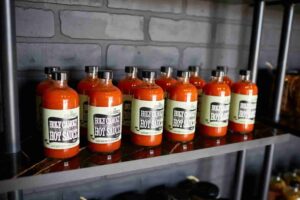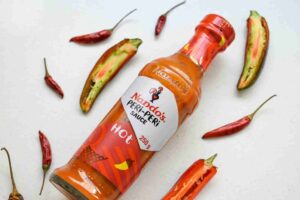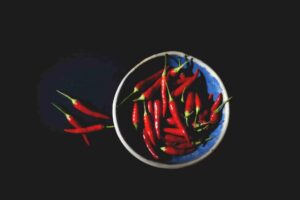In December 2023, DataHorizzon Research reported that the Hot Sauce Market, valued at USD 2.8 Billion in 2022, is poised to reach USD 5.3 Billion by 2032 with a 6.8% CAGR. The market’s expansion is driven by the rising demand for cross-cultural foods, the preference for spicy meals, and the health benefits of capsaicin in chili peppers. Social media amplifies hot sauce brands, fostering positive reviews. Big players target semi-rural areas, enhancing market opportunities amid strong competition.
Discover the surging popularity of hot sauce in the market! Ever considered crafting your own? Select fresh ingredients, tailor it to your taste, and delve into the art of DIY hot sauce. What materials are essential? What nuances require attention? Plus, explore efficient cost-saving methods. If you are interested, let’s embark on this flavorful journey together!

Section 1 Ingredients and Equipment
| Ingredients for DIY Hot Sauce | Essential Equipment |
| Fresh chili peppers: a variety of choices | Blender or food processor |
| Vinegar: white or apple cider) | Saucepan |
| Garlic cloves | Fine mesh strainer or cheesecloth |
| Onion | Glass sauce bottle with a tight-sealing lid |
| Salt | Funnel: for easy pouring |
| Sugar: optional for sweetness | Gloves: to protect hands when handling hot peppers |
Section 2 Step-by-Step Process
○ Prepare Ingredients: Wash and chop a selection of fresh chili peppers, garlic cloves, and onion.
○ Cooking Base: In a saucepan, combine the chopped ingredients with vinegar, salt, and optional sugar. Simmer the mixture until peppers, garlic, and onion soften.
○ Blend: Transfer the cooked mixture to a blender or food processor. Blend until you achieve a smooth consistency.
○ Strain: Strain the blended sauce using a fine mesh strainer or cheesecloth to remove any solids.
○ Bottle: Use a funnel to pour the strained hot sauce into a glass bottle.
○ Cool and Store: Allow the sauce to cool before sealing the bottle. Store the hot sauce in the refrigerator to maintain freshness.
The video outlines the production steps, highlights necessary precautions, and could offer additional inspiration.
Section 3 Choosing the Right Hot Sauce Bottle
The right container for hot sauce packaging enhances the product’s identity, influences consumer perception, and ensures freshness. Here are some tips on finding suitable containers:
Specialized Retailers: Explore stores that specialize in kitchenware or packaging supplies.
○ Online Suppliers: Numerous online suppliers offer a variety of glass bottles suitable for hot sauce.
○ Local Craft Stores: Check local craft stores for unique and appealing bottle options.
○ For bulk orders, consider reaching out to us directly. We offer empty wholesale glass hot sauce bottles, customizable to your specific requirements.
For additional guidance, check our blog on How to Choose the Perfect Glass Sauce Bottles.

Section 4 Flavor Customization
When customizing hot sauce flavors, we can experiment with various chili peppers, aromatics, and spices to achieve the desired taste profile. Adjust the spice level by controlling the type and quantity of peppers used. Balancing acidity with vinegar and sweetness with sugar can enhance complexity. Consider infusing unique flavors like fruits or herbs for a distinctive touch. Regularly taste and adjust during cooking to achieve the perfect blend, ensuring the hot sauce caters to diverse preferences.
For example, we can begin with a base flavor that complements the type of product you are working on. Whether it’s a beverage or a food item, a well-defined base flavor is the foundation for experimentation. We will need to familiarize ourselves with different flavor profiles. Identify the primary tastes such as sweet, sour, salty, bitter, and umami. This will help balance flavors and create a harmonious blend.
Whenever possible, use fresh and high-quality ingredients. Fresh herbs, spices, fruits, and vegetables can significantly enhance the overall flavor of your product. Please note it’s better to make small and gradual adjustments when experimenting with flavors and spice levels. This allows you to taste the changes without overwhelming the product.
It’s recommenedly that we keep a detailed record of the ingredients and quantities you use during each experiment. This will help replicate successful combinations and avoid repeating less favorable ones. Experiment with contrasting flavors to create interesting and dynamic profiles. For example, pairing sweet and spicy or combining citrusy and savory elements can lead to unique and appealing results. When working with spicy elements, be mindful of the heat levels. Gradually increase spice levels to find the right balance without overpowering the overall taste.

Conclusion
DIY hot sauce at home can be a rewarding journey of culinary. The joy lies not only in the end product but also in the process itself. Experiment with various ingredients, embrace the unexpected, and tailor your hot sauce to your unique taste preferences. For those passionate about both cooking and innovation, this is an opportunity to not only indulge in their culinary creativity but also embark on a potential hot sauce business venture.
The satisfaction derived from turning a passion into a profitable venture is immeasurable. Beyond the joy of creating something truly exceptional, there’s the fulfillment of meeting the demands of a growing market of discerning consumers.











